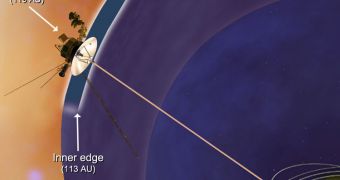The NASA Voyager 1 space probe is currently making its way through a cosmic purgatory of sorts, officials in charge of the mission say. The spacecraft is currently at the edge of the solar system, where it's plowing its way through extremely-hostile conditions.
The purpose of the mission is to study interstellar space. In order to do that, it has to travel outside the solar system, and the probe has been moving through the very boundaries of the Sun's influence for several years now.
However, the boundary layer, known as the heliopause, is apparently a lot larger than first suspected. The area does not exist in the strictest sense, but is rather a theoretical location where the influence of the solar wind is equaled by the influence exerted on the solar system by the interstellar medium.
At Voyager 1's current location, the intensity of the solar wind has died down, but the Sun's magnetic field is still strong. This suggests that the spacecraft is still inside the heliosphere, which is the cloud of charged particles our star produces around itself as it travels through space.
One of the most interesting discoveries the probe made thus far was that high-energy particles from within the solar system appear to be leaking out into interstellar space through the heliopause.
“Voyager tells us now that we're in a stagnation region in the outermost layer of the bubble around our solar system. Voyager is showing that what is outside is pushing back. We shouldn't have long to wait to find out what the space between stars is really like,” Ed Stone explains.
The expert – who is based at the California Institute of Technology (Caltech), in Pasadena – holds an appointment as a project scientist for the Voyager mission. At this time, the spacecraft is located about 11 billion miles (18 billion kilometers).
This is the equivalent of 119 astronomical units (AU) away from Earth. An AU is the mean distance between our planet and the Sun, calculated at around 150 million kilometers (93 million miles).
The new discovery was presented yesterday, December 5, at the fall meeting of the American Geophysical Union (AGU). The conference is held in San Francisco. Experts also said that the probe may move to interstellar space in less than a year.
“For the first time, the [interstellar] wind even blows back at us. We are evidently traveling in completely new territory. Scientists had suggested previously that there might be a stagnation layer, but we weren't sure it existed until now,” Rod Decker explains.
The expert is based at the Johns Hopkins University (JHU) Applied Physics Laboratory (APL), in Laurel, Maryland. He is also a co-investigator for the Low-Energy Charged Particle Instrument aboard the Voyager 1 spacecraft.

 14 DAY TRIAL //
14 DAY TRIAL //